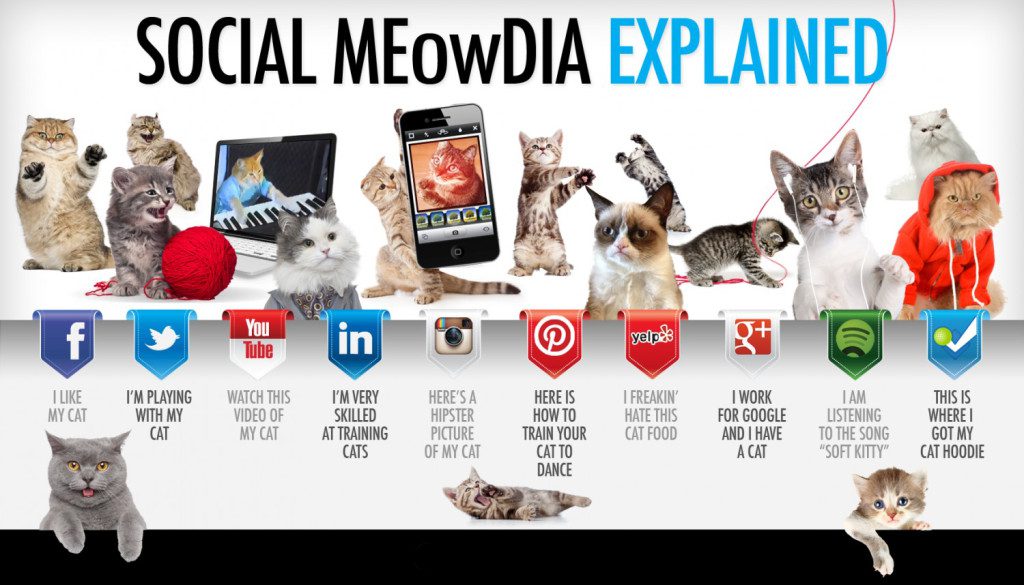Before starting a social media account, ask yourself?
- What does my school, program or organization hope to accomplish through social media?
- Outline your goals in order to properly track the return of your investment. Ensure you are properly seizing the available opportunity to elevate the perception of our programs, and success of the University as a whole.
- Where is my target demographic?
- Concentrate your efforts on one platform before increasing your social media presence. Take the time to engage, educate and inform. Social media is about transparency and customer service.
- Do I have the content to sustain a dedicated social presence, or am I an initiative that would benefit more from a hashtag and collaborative promotion on central
 accounts?
accounts?
Successful social media community managers update Facebook one to two times each day and Twitter, five to seven times a day. Programs that are unable to meet the content requirements to sustain a dedicated social account should partner with central accounts to serve thier social meda needs. We’re here to help!
Requirements Before You Start
Get Registered, Be Official!
All accounts must be registered to be includeded in official directory of university social media accounts.
Make A Plan
Define your goals: Clearly defining your goals can help you choose what social media channel is best suited for your primary objective. Think about your organization’s communications and marketing and how these social media channels will help you achieve your goals.
Determine a manager: Designating a coordinator role to one or more persons in your department will ensure that you maintain a focus on your social media goals.
Determine a plan: What are your marketing goals and how does social media fit within those goals? Whatever your goals may be, clearly define them so you can always use them as a point of reference while you manage your accounts.
Listen and monitor: How comfortable and knowledgeable are you about the platforms and audiences? Take the time to listen to the different channels before engaging so you have a clear understanding of audience.
The right tool for the right job: Be aware of current and emerging tools, but try to consider ones that will further your marketing goals. Spreading yourself too thin can jeopardize your valuable audiences.
Identifying yourself: Creating an account name that demonstrates your association with Jackson State University as well as your literal name is the best approach.
Launch & Adjust: Once you’ve gone through the first six steps, you are ready to launch your social media site! Tell us about it, add other JSU departments and begin to add your target audience. Go forward with your intended message and goals.
Popular Social Media Platforms
Facebook is a social networking site that connects people to other individuals. Organizations and brands are able to create pages and groups to also connect to these individuals. It is a network driven by status updates, games and applications, and content sharing such as links and photos.
Pages vs. Groups: Fan pages typically work best for most uses. A fan page allows a brand or entity to connect with people without using a personal account. Applications can be added to increase personality of the brand. Groups are designed to be more personalized, especially around common interests a group may share.
Creating Your Account: To set up a Facebook Page, follow the instructions provided by Facebook. Set up at least two administrators for this account, with one serving as backup in case there are access problems with the original account. Creating a fake account as the administrator of an official Facebook page is strongly discouraged as it runs counter to Facebook’s Terms of Service.
Picking & Setting Up A Page Name: When choosing your page name, make sure it is as literal and identifiable as possible. All JSU related social pages should have ‘JSU’ in the name (i.e. JSU Recruitment, JSU Division of Undergraduate Studies.) You want people to be able to search and find you. . For example, the official Jackson State University Facebook page is titled “Jackson State University” and the url is Facebook.com/JacksonState. Once you’ve considered a name, go to http://www.facebook.com/username/ and see if the username you chose is available. Remember, once you select a username it can not be altered. Learn more from Facebook’s Help Center.
Twitter defines their site as “an information network made up of 280-character messages from all over the world.” Essentially, Twitter is a short dialogue where people can post about anything, and have conversations back and forth. A tweet can be no longer than 280 characters.
The following are symbols and definitions that you should familiarize yourself with for your department’s Twitter account:
Username: Also known as a Twitter handle. Must be unique and contain fewer than 15 characters. Is used to identify you on Twitter for replies and mentions.
@: The @ sign is used to call out usernames in Tweets, like this: Hello @Twitter! When a username is preceded by the @ sign, it becomes a link to a Twitter profile.
Reply: A Tweet posted in reply to another user’s message, usually posted by clicking the “reply” button next to their Tweet in your timeline. Always begins with @username.
Mention: Mentioning another user in your Tweet by including the @ sign followed directly by their username is called a “mention”. Also refers to Tweets in which your username was included.
Retweet: The act of forwarding another user’s Tweet to all of your followers. Someone else can also perform this action, which is still called a retweet.
Trending Topic: A subject algorithmically determined to be one of the most popular on Twitter at the moment.
Hashtag: The # symbol is used to mark keywords or topics in a Tweet. A complete list of definitions can be found at Twitter Support.
Creating Your Department’s Account: The easiest way to set up your Twitter Profile is to first create an e-mail account for your specific department. You don’t want to use your personal account.
o Navigate to http://twitter.com/, enter your Department’s name and click the yellow button on the right hand of your screen.
o Fill in the first field with your Department’s name.
o Select a username from one of the usernames Twitter suggests, or create one that best suits your Department. Try to make your username as short as possible – when others retweet messages from your tweet stream, the length of your name reduces the number of available characters in their tweet, which might mean they will cut out or edit your tweet to make it possible to send (which can result in an electronic version of the ‘Telephone Game’ of misunderstood statements)
o Enter a password and make sure to document this for later use. It’s advised that your password contains letters, numbers, and symbols.
o Enter the email address you made for your department.
o Pick sources that are related to your Department.
o Search for Jackson State University, and begin following all of the current Twitter accounts affiliated with the university.
YouTube
YouTube is a video-sharing website where users can upload, view and share videos from around the world.
What kind of content do we post?
The Jackson State University YouTube channel houses videos related to university news, events, student and faculty profiles, etc.
Best Practices for a Successful Social Media Presence
Protect confidential and proprietary information: Do not post confidential or proprietary information about Jackson State students, employees, or alumni. Employees must still follow the applicable federal requirements such as FERPA and HIPA, as well as NCAA regulations. Adhere to all applicable university privacy and confidentiality policies. Employees who share confidential information do so at the risk of disciplinary action or termination.
Respect copyright and fair use: When posting, be mindful of the copyright and intellectual property rights of others and of the university. For guidance about fair use or copyrighted material call the Office of Contractual Services at 601-979-1065.
Respect university time and property: University computers and time on the job are reserved for university related business as approved by supervisors.
Terms of service: Obey the Terms of Service of any social media platform employed.
Think twice before posting: Privacy does not exist in the world of social media. Consider what could happen if a post becomes widely known and how that may reflect both on the poster and the university. Search engines can turn up posts years after they are created, and comments can be forwarded or copied. If you wouldn’t say it at a conference or to a member of the media, consider whether you should post it online. If you are unsure about posting something or responding to a comment, ask your supervisor for input or contact the University Communications at 979-2272.
Strive for accuracy: Only post verified factual information on social media. Review content for grammatical and spelling errors. This is especially important when posting on behalf of the university in any capacity. (See “Institutional social media” below.)
Answer Questions: It’s important to be available, helpful and friendly. Answer user questions, and pose questions of your own. This interaction will help create a mutually beneficial relationship.
Post and Comment. It’s always important to post interesting content for your site, but remember to also comment on postings of others in your audience. This will also help create the conversation that social media sites allow between you and your audience.
Be respectful: Understand that content contributed to a social media site could encourage comments or discussion of opposing ideas. Responses should be considered carefully in light of how they would reflect on the poster and/or the university and its institutional voice.
Remember your audience: Be aware that a presence in the social media world is or easily can be made available to the public at large. This includes prospective students, current students, current employers and colleagues, and peers. Consider this before publishing to ensure the post will not alienate, harm, or provoke any of these groups.
On personal sites: Identify your views as your own. If you identify yourself as a JSU faculty or staff member online, it should be clear that the views expressed are not necessarily those of the institution. Do not use the Jackson State logo or any other university images or iconography on personal social media sites. Do not use Jackson State’s name to promote a product, cause, or political party or candidate.
Photography: Visitors can appropriate Photographs posted on social media sites easily. Consider adding a watermark and/or posting images at 72 dpi and approximately 800 x 600 resolution to protect your intellectual property. Images at that size are sufficient for viewing on the Web, but not suitable for printing.
Terms of service: Obey the Terms of Service of any social media platform employed.
For more information about this document, contact University Communications at 601-979-2272.





